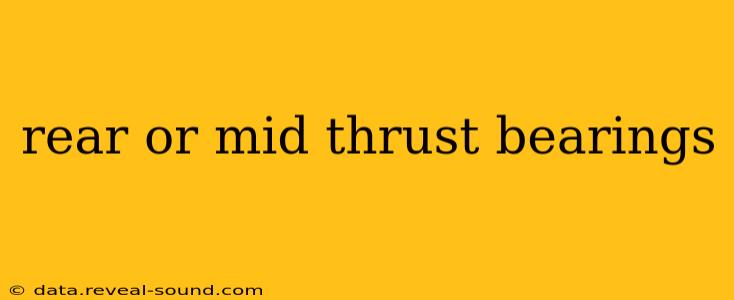Rear vs. Mid Thrust Bearings: A Comprehensive Guide
Choosing the right type of thrust bearing is crucial for the smooth and efficient operation of rotating machinery. Two common types are rear thrust bearings and mid thrust bearings, each with its own advantages and disadvantages. This guide will delve into the differences, applications, and considerations for selecting between these two crucial components.
What is a Thrust Bearing?
Before diving into the specifics of rear and mid thrust bearings, let's establish a foundational understanding. A thrust bearing is a type of bearing designed to withstand axial loads—forces pushing or pulling along the shaft's axis. Unlike radial bearings, which primarily handle radial loads (forces perpendicular to the shaft), thrust bearings are essential for preventing axial movement and ensuring stable operation in various applications.
Rear Thrust Bearings: Design and Applications
Rear thrust bearings, as the name suggests, are positioned at the rear end of a rotating shaft. Their design typically involves a stationary race (housing) and a rotating race (attached to the shaft). The bearing surfaces are precisely machined to allow for smooth axial movement while minimizing friction and wear.
Advantages of Rear Thrust Bearings:
- Simplified Design: Often simpler in design and construction compared to mid-thrust bearing arrangements.
- Easier Installation and Maintenance: Access for inspection and maintenance is typically easier due to their location.
- Cost-Effective: Can be more cost-effective in certain applications due to their simpler design.
Disadvantages of Rear Thrust Bearings:
- Potential for Increased Shaft Deflection: The entire axial load is concentrated at one point, potentially leading to increased shaft deflection, especially in long shafts.
- Limited Load Capacity in Certain Applications: May not be suitable for applications requiring extremely high axial loads.
- Less Efficient Heat Dissipation (Sometimes): Depending on design, heat dissipation can be less efficient compared to other configurations.
Typical Applications:
Rear thrust bearings are commonly used in applications where the axial load is relatively low and the design simplicity is prioritized, such as:
- Small pumps and motors
- Fans and blowers
- Simple rotating machinery
Mid Thrust Bearings: Design and Applications
Mid thrust bearings, unlike their rear counterparts, are located at the midpoint of the shaft. This strategic placement helps to distribute the axial load more evenly along the shaft, mitigating potential issues associated with shaft deflection. They often employ a more complex design, utilizing multiple bearing elements or a combination of bearings to handle the load effectively.
Advantages of Mid Thrust Bearings:
- Improved Shaft Stiffness: Better distributes axial load, resulting in increased shaft stiffness and reduced deflection.
- Higher Load Capacity: Often capable of handling significantly higher axial loads compared to rear thrust bearings.
- Better Heat Dissipation: Optimized design can provide superior heat dissipation.
Disadvantages of Mid Thrust Bearings:
- More Complex Design: More intricate design leads to increased manufacturing complexity and cost.
- More Difficult Installation and Maintenance: Access for installation and maintenance can be more challenging.
- Potentially Higher Initial Cost: Higher initial cost due to complexity and precision manufacturing requirements.
Typical Applications:
Mid thrust bearings are generally preferred for applications demanding high axial load capacity, improved shaft stability, and efficient operation, such as:
- Large turbines and generators
- High-speed rotating machinery
- Heavy-duty industrial applications
What are the Differences Between Rear and Mid Thrust Bearings?
The key differences lie in their location on the shaft, load distribution, and resulting implications for shaft stiffness, load capacity, and cost. Rear bearings are simpler and cheaper but may not be suitable for high loads, while mid bearings offer better load distribution and higher capacity but are more complex and expensive.
How Do I Choose Between Rear and Mid Thrust Bearings?
The selection process depends entirely on the specific application requirements. Factors to consider include:
- Magnitude of the Axial Load: Higher loads necessitate mid-thrust bearings.
- Shaft Length and Stiffness: Long shafts may benefit from mid-thrust bearing’s superior load distribution.
- Operating Speed: High-speed applications may require mid-thrust bearings for enhanced stability.
- Budget Constraints: Rear thrust bearings offer a more cost-effective solution for low-load applications.
- Maintenance Accessibility: Consider the ease of access for inspection and maintenance.
What are the types of thrust bearings?
Beyond rear and mid placement, numerous thrust bearing types exist, each with unique design characteristics and applications. These include ball thrust bearings, roller thrust bearings, tapered roller thrust bearings, and many more specialized designs catering to specific operational requirements. The choice of bearing type extends beyond placement, influencing overall performance and longevity.
By carefully considering these factors, engineers and designers can select the optimal thrust bearing arrangement to ensure the reliable and efficient operation of their machinery. Remember to consult bearing manufacturer specifications and engineering handbooks for detailed information and selection criteria specific to your project.
